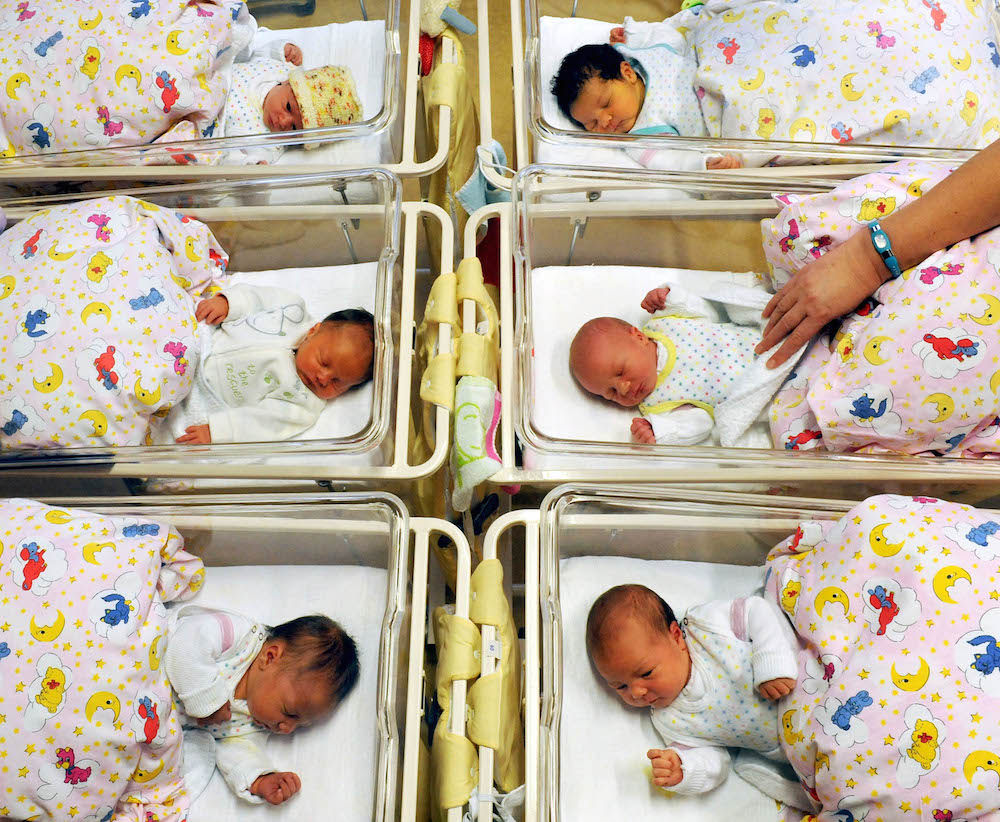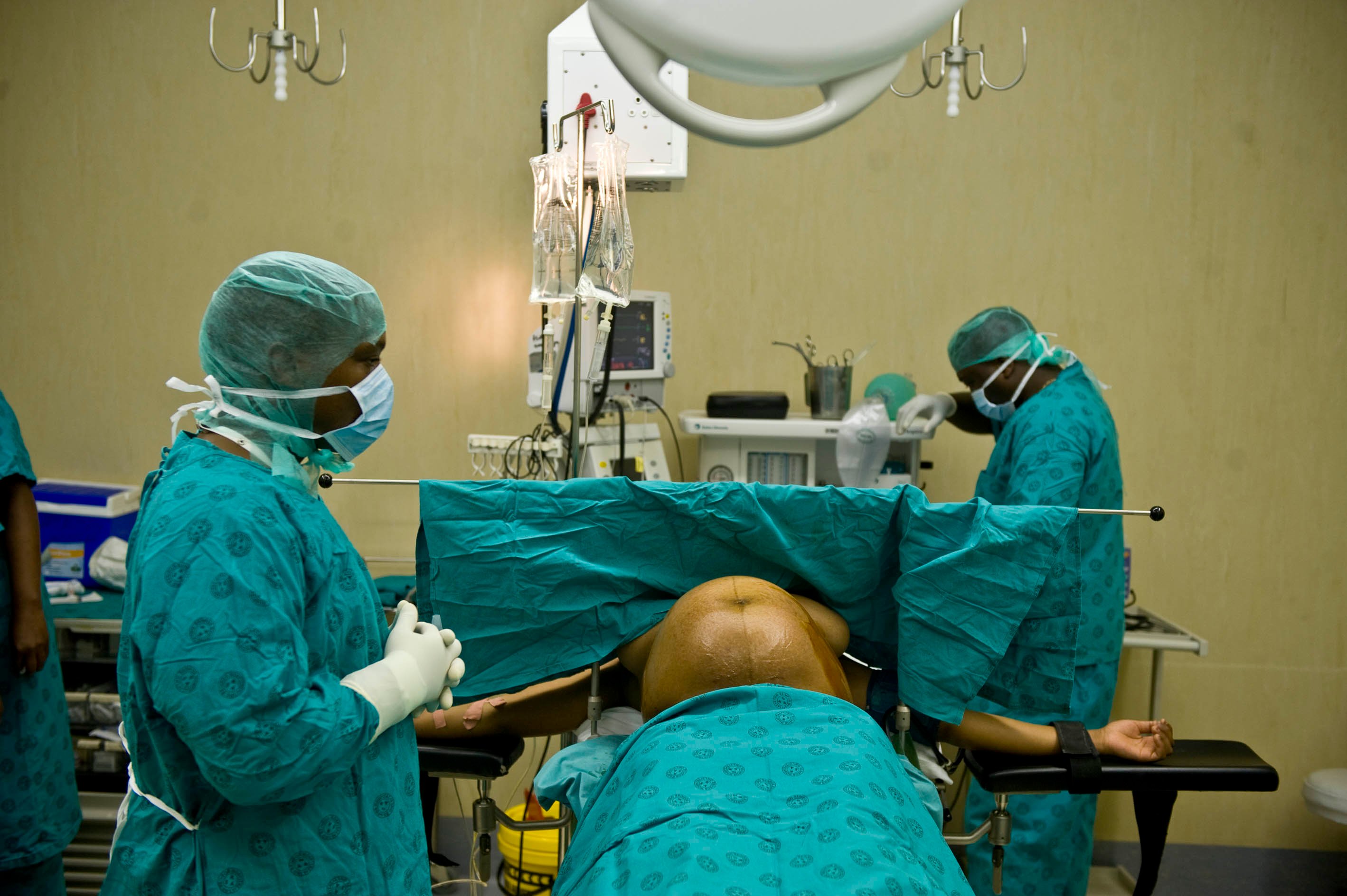A mother delivers via C-section in Mozambique. In South Africa, theres no single reason for the climbing number of such procedures in the public sector but it could be proving deadly for mothers. (Shaun Swingler)
For decades, caesarean sections were a last resort for mothers and babies in distress. If you had access to this kind of procedure, you could count yourself among the world’s lucky.
At the dawn of the 21st century, rates of the procedure in almost all African regions save for the continent’s north dragged along at less than 5%, recently published research in The Lancet shows. Meanwhile, the continent was home to more than half of the 13 countries responsible for the majority of the world’s maternal deaths, World Health Organisation (WHO) data from the year 2000 shows.
At the same time, C-section rates in much of Asia and Eastern Europe hovered around 7%.
Almost 30-million babies will come into the world this year by caesarean if 2015 figures are anything to go by — nearly double the number of infants delivered in this way almost two decades before, a recent article published in The Lancet shows. The journal recently dedicated an entire series of articles that examined why C-section rates around the world are skyrocketing.
South Africa hasn’t escaped the caesarean surge. About 26% of babies born in South African public hospitals are born by caesarean, the latest available figures from the 2015/2016 District Health Barometer report show.
The annual publication charts health data from each of the country’s 52 health districts. In our district hospitals alone the rate is 24%. In 2001, about 13% of deliveries in district hospitals resulted in C-sections, earlier versions of the publication reveal.
But what’s driving this increase? When researchers behind The Lancet study looked at the numbers globally, they told a story of richer and poorer — as well as of progress and peril.
It’s a tale playing out right here at home.
Globally, who gets a C-section is now often determined by factors such as income and education rather than by sheer emergency. When scientists looked at data from 169 countries, caesareans were almost five times more frequent among the wealthiest people in low- and middle-income countries. Educated women in countries such as Brazil and China also often elected to have the procedure even when their deliveries were low-risk, The Lancet study found.
In contrast, many women in low-income and even in some middle-income countries, especially in sub-Saharan Africa, still don’t have access to the procedure — putting them at a higher risk of maternal death.
Almost twice as many procedures were performed in the private sector as in public health facilities, The Lancet study found.

The chance of our birth: The proportion of babies born via C-section across the world is rising but not in some of the places where women need it the most. (Waltraud Grubitzsch/AFP)
In South Africa, about six out of 10 mothers in the private sector delivered by C-section in 2017, the Council for Medical Schemes’ annual report reveals.
Linda van Wyk* knew she wanted a caesarean section from the moment she realised she was pregnant.
“I didn’t get maternity leave so I had to maintain myself and plan carefully for the four months I was taking off work,” she says.
“I told my doctor that a C-section would allow me to meticulously schedule my daughter’s birth and work until the last moment, and she never told me that I couldn’t.”
In the public sector, there’s no single answer to why C-section rates are climbing, the national health department’s deputy director general for communicable and noncommunicable diseases, Yogan Pillay, says.
Instead, reasons lie in everything from better access to services to declining use of other methods for dealing with difficult births.
For instance, the percentage of women who delivered at health facilities and not at home rose by 26 percentage points between 2001 and 2009, a 2010 Statistics South Africa report shows.
Increased access to medical services hasn’t just raised the overall rate of C-sections in the public sector, it has also created “hot spots”.
The largest number of caesareans take place at hospitals able to provide higher levels of care — in other words — regional, tertiary or central hospitals, according to the 2015/16 District Health Barometer.
But not every district has these kinds of facilities, meaning that those that do often cater for cases referred from their neighbours, Pillay explains.
Five district municipalities have C-section rates of 34% or more: the Eastern Cape’s Nelson Mandela Bay and Buffalo City districts, as well as Amajuba, Umgungundlovu and Ugu districts in KwaZulu-Natal.
“[These] are all districts with tertiary hospitals,” Pillay explains.
“These hospitals receive referrals for surrounding districts, and it is expected that the C-section rates will be higher in these areas because of the more complex nature of the cases they see.”
Mapping South Africa’s C-section ‘hot spots’
Click on a district to see how district C-section rates compare to the national average. Find out more about the map and the data here.
Caesareans may also be on the rise because other traditional techniques — such as the use of forceps or vacuum suction — to help deliver babies are on the decline, he argues.
A 2018 South African Medical Journal study found that less than one percent of births happen with this kind of assistance, a rate researchers say is too low and probably indicative of a lack of skills, equipment or willingness to perform assisted deliveries among healthcare workers.
And more doctors are simply afraid to deliver babies naturally for fear of litigation, Pillay explains.
In 2017, Health Minister Aaron Motsoaledi told Bhekisisa that claims against the health department since 2011 totalled more than R50-billion — or a third of the whole public healthcare budget at the time.
Obstetricians and gynaecologists are particularly vulnerable to allegations of botched births, leading to a ninefold increase in premiums to insure their practices against litigation in the past decade, he said.
“Obstetricians and gynaecologists are the prime targets,” he said. “Why is this so? They work in areas where adverse events or complications are more likely to happen.”
Just how many babies should be born via C-sections has been debated for decades. The WHO has historically said “there [was] no justification for any region to have caesarean section rates higher than 10-15%”, based on a 1985 WHO expert meeting.
A 2014 review published in the journal Birth reviewed data from 19 countries, mostly in Europe and North America, and found that, although C-section rates had risen markedly in each over three decades, increases above 10% had no effect on maternal mortality when factors such as increases in quality of life and economy were factored in.
But there is no universally accepted benchmark for just how many C-sections should happen in countries, the Health Systems Trust says. This is why the research organisation no longer includes it in their District Health Barometer.
“While the caesarean section rate is important in various contexts as an indicator, with no absolute target value, it isn’t necessarily a good option for summarising district health system performance,” the organisation says.
Ultimately, it may be less about benchmarks and more about ensuring women can have a C-section when they need it.
“There is no ideal C-section rate,” Pillay says. “The idea is to ensure that all those women who require a C-section have access to one.”

The Caesarean surge: The health department has proposed vetting hospitals to make c-sections safer in the public sector but a recent report says this kind of accreditation hasn’t happened and could make Caesareans virtually unavailable in some areas. (Paul Botes)
But that doesn’t mean that the health department isn’t worried about the increase in procedures, which aren’t without expense or risk. C-sections can cost up to almost 60% more in the public sector than a natural birth, according to a presentation by Matan Abraham of Insight Actuaries and Consultants to the Actuarial Society of South Africa in October 2017.
The country’s latest report on maternal deaths also found a sharp increase in deaths from injuries incurred during C-sections between 2014 and 2016. Researchers argue this may indicate, in part, a growing trend as doctors contend with a greater number of difficult repeat caesarean sections. More than half of women who die of obstetric haemorrhage had caesarean deliveries, the report found.
“The mortality rate of women having caesarean sections was three times higher than those having normal deliveries,” the report warns.
Other risk factors for mothers going under the knife included risks associated with poor staffing at hospitals, particularly for anaesthesia.
“It is absolutely unacceptable and unethical that spinal anaesthesia is being administered to mothers by doctors who are unable to deal with the complications … and who are also unable to … administer safe general anaesthesia,” authors argue.
“Equally untenable and unethical is the ‘single operator’ for a caesarean delivery, where one doctor administers the anaesthetic and performs the caesarean section.”
In contrast, mothers undergoing the procedure in the private sector are attended to by teams of healthcare workers, including nurses, obstetricians and anaesthetists.
In recent years, the national health department has introduced its safe caesarean delivery programme in a bid to make C-sections safer. The project is supposed to include the development of criteria that would accredit facilities to provide safe C-sections by, for instance, ensuring that they have enough doctors with the surgical and anaesthetic skills to perform the procedures. But the programme and these standards have yet to be implemented, the latest national maternal death audit revealed in January.
Researchers warned that some public facilities would be unable to meet criteria and this was likely to result in some services closing — which could mean that some women would have to travel farther to access caesareans.
“I felt safe with a C-section because it happened in the private sector where a gynaecologist, assisted by a GP, a nurse, an anaesthetist and a paediatrician, performed my procedure. If anything went wrong, there were more than enough qualified staff to take care of my baby and me,” Van Wyk says.
“I’m not sure I would have made this choice if I had to rely on the much less-equipped public sector, where a GP and nurse would most probably have been the only resources,” the mother of one explains.
“Besides, the public sector wouldn’t have allowed me this choice; my choice in the private sector was a luxury.”